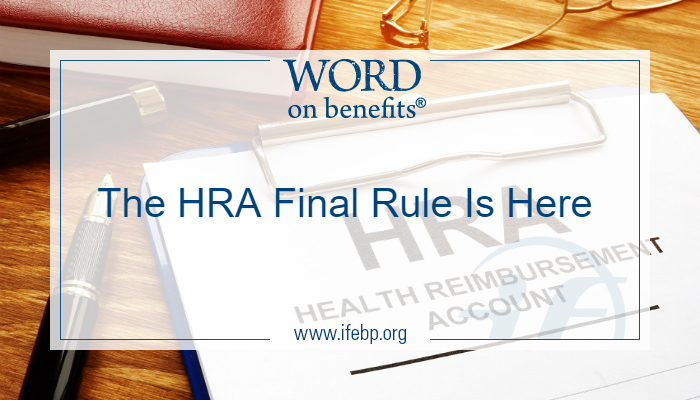Original Source: https://blog.ifebp.org/index.php/hra-final-rule-excepted-benefit-hra
On June 13, 2019, the Departments of Labor, Treasury, and Health and Human Services (the Departments) jointly issued a final rule to expand the flexibility and use of health reimbursement arrangements (HRAs).
The final rule, which is effective August 19, 2019 and applicable for plan years beginning on or after January 1, 2020, creates two new types of HRAs—the individual coverage HRA (ICHRA) and the excepted benefit HRA. It also leaves all existing HRA designs intact.
This two-part blog covers what you need to know about these two new types of HRAs. Keep reading to learn about excepted benefit HRAs and check the June 27 Word on Benefits blog post for more on ICHRAs.

Excepted Benefit HRA
The excepted benefit HRA offers employers of any size an opportunity to use pretax dollars to reimburse certain limited benefits if the conditions of the final rule are satisfied.
An employer may not offer both an excepted benefit HRA and an ICHRA to the same employee.
Is the excepted benefit HRA integrated with a group health plan?
Not exactly. The final rule requires that the excepted benefit HRA must not be an integral part of the employer’s group health plan (i.e., to ensure that the benefits offered under the HRA are, indeed, excepted and not a part of the plan). However, to satisfy this requirement, the employer still must offer a separate group health plan to any employees who are offered the excepted benefit HRA in a given plan year. The eligible employee does not actually have to enroll in the group health plan to receive coverage under the excepted benefit HRA.
The final rule clarifies that requiring enrollment in the group health plan would prevent employees who have coverage through a spouse’s group health plan from participating in the excepted benefit HRA. The rule adds that “Applying such a restrictive requirement would unduly limit some employees’ access to excepted benefit HRAs and reduce their welfare if they choose a different primary health coverage option to best meet their needs.” Additionally, the Departments do not anticipate that many eligible employees will forgo the group health plan and rely on the excepted benefit HRA as primary coverage.
Is the excepted benefit HRA a group health plan?
Yes. On its own, the excepted benefit HRA is a group health plan, separate from the associated traditional group health plan that the employer must also offer. Both group health plans are generally subject to ERISA.
How much can an employer contribute?
The final rule establishes one contribution limit, regardless of a participant’s age or number of dependents, which is indexed annually for inflation. For plan years beginning on or after January 1, 2020 (when the final rule is first applicable), the limit is $1,800.
Year-to-year carryover amounts are not counted toward the annual limit, but any employer contributions to other HRAs that reimburse more than just excepted benefits must be aggregated to determine whether the annual limit is exceeded.

Do the same ICHRA employee classes apply to excepted benefit HRAs?
No. Instead, the excepted benefit HRA must be made available under the same terms to all similarly situated individuals, regardless of health factor. Similarly situated individuals are defined by HIPAA nondiscrimination rules, which distinguish similar groups of employees based on bona fide employment-based classifications. The Departments finalized this condition to prevent discrimination based on health status and to stop an employer from offering a more generous excepted benefit HRA to a less healthy participant as an incentive not to enroll in the associated traditional group health plan.
What expenses can be reimbursed?
While the employer has the flexibility to include any or all of these in its plan design, excepted benefit HRAs can reimburse any of the following qualified expenses:
- IRC Section 213(d) expenses that are not covered by the associated traditional group health plan
- Limited-dental and limited-vision plan premiums and/or cost sharing
- COBRA premiums and/or cost sharing
- Premiums and/or cost sharing for short-term limited-duration (STLD) plans (with some exceptions).
Excepted benefit HRAs may NOT reimburse premiums for:
- Individual coverage (if the insurance covers more than just excepted benefits)
- Group health plan coverage (if the group health plan covers more than just excepted benefits)
- Medicare Parts A, B, C and D (a change from the proposed rule).
Cost sharing for any of these types of coverage are still reimbursable through an excepted benefit HRA.
What notices are required?
The final rule does not require any additional notice requirements for excepted benefit HRAs beyond required ERISA disclosures. However, in future rulemaking, the Department of Health and Human Services (HHS) intends to propose a notice requirement with respect to nonfederal governmental plan excepted benefit HRAs.
Does the limited-purpose HRA still exist?
Yes. A limited-purpose HRA, which was created to be compatible with a health savings account (HSA), only reimburses preventive care benefits, permitted insurance (for a specific disease or a fixed amount per day of hospitalization) or permitted coverage, which includes vision care, dental care, accidents and disability.
The final rule clarifies that the limited-purpose HRA still exists and is different from the excepted benefit HRA because it does not include any annual contribution limits and has different reimbursable expenses.

Anything else?
Here are a few miscellaneous considerations:
- Compatibility with HSAs: An excepted benefit HRA can be offered in conjunction with an HSA so long as the excepted benefit HRA is not used to obtain coverage that is not HSA compatible.
- COBRA: Because the excepted benefit HRA is a group health plan, COBRA continuation rules apply.
Ultimately, it is important for employers to remember that this final rule creates two new HRA options but does not affect any compliant HRA plans that currently exist. Employers are not required to make any changes to current plan designs.
Be sure to check out The HRA Final Rule Is Here (Part 1) to read more about the final rule and individual coverage HRAs (ICHRAs).
Resources
- Final Regulations, Federal Register, June 20, 2019
- Final Rule on Health Reimbursement Arrangements Could Shake Up Markets, Health Affairs, June 14, 2019
Developed by International Foundation of Employee Benefit Plans staff. This does not constitute legal advice. Consult your plan professionals for legal advice.
![]()
Rose Plewa, CEBS
Senior Instructional Designer, Online Learning Department at the International Foundation
Original Source: https://blog.ifebp.org/index.php/hra-final-rule-excepted-benefit-hra






